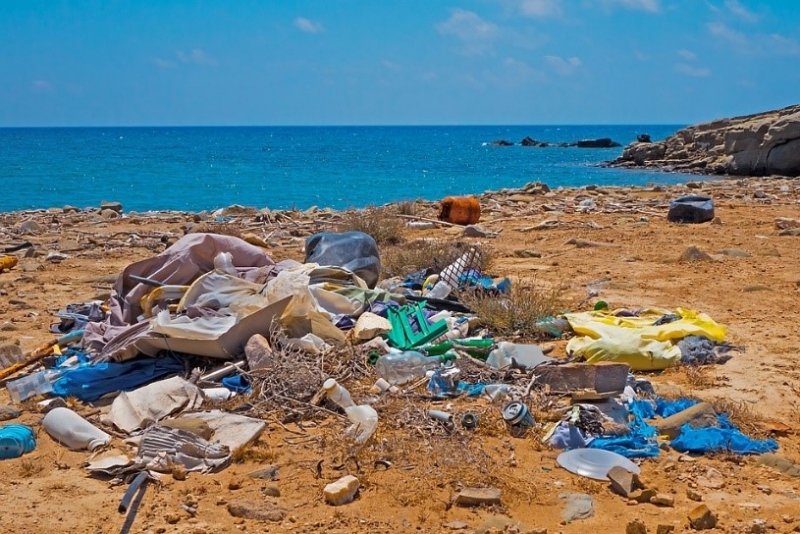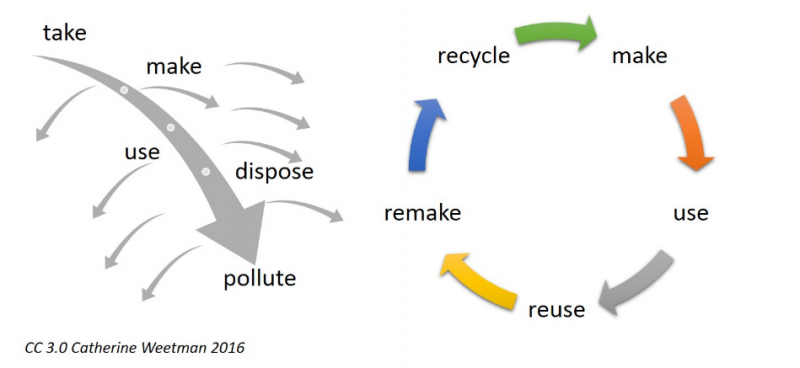It is hard to ignore the pervasiveness of waste in our daily lives and around the world. Whether it is mounds of garbage piling onto beaches in the Dominican Republic, the enormous amounts of plastic that marine animals accidentally consume, pollution from industries and transportation in our air and water, or daily individual waste, we cannot look past the impacts of generating unnecessary waste.
 Although many actors have been working on initiatives to change our habits and behaviors, the structure of our economy hinders us from truly seeing results. Our capitalist society is built on a linear model of resource use in which materials travel through a “cradle-to-grave” chain of extraction, manufacture, consumption, and collection or emission after use. This model is unsustainable, especially on a global scale, yet it is the dominant form of business and exchange.
Although many actors have been working on initiatives to change our habits and behaviors, the structure of our economy hinders us from truly seeing results. Our capitalist society is built on a linear model of resource use in which materials travel through a “cradle-to-grave” chain of extraction, manufacture, consumption, and collection or emission after use. This model is unsustainable, especially on a global scale, yet it is the dominant form of business and exchange.
Now more than ever, it is imperative to consider alternatives to this traditional approach—one that allows us to treat the problem at its source, instead of merely reacting to the problem. New models have gained traction in the past few years to help us move forward. One of these emerging models is a circular economy approach that emphasizes sustainable development and aims to achieve economic, social, and environmental well-being through cleaner technology and business practices. This model draws from the concept of industrial ecology, which promotes a closed-loop system of energy and material flow to minimize waste. Through these approaches, companies work to convert energy and materials into reusable products. A circular economy model therefore has the potential to revolutionize the way we deal with waste and prevent further environmental degradation.

Linear vs. Circular Economy Courtesy of Catherine Weetman (2016), Wikimedia Commons
The circular economy approach has been implemented at different scales around the world. Japan and Germany have taken a number of steps to incorporate circular elements into their economies. China, one of the world’s largest producers of waste, has also begun to experiment with a circular economy by enacting changes in its fiscal and industrial policies that favor eco-friendly companies and infrastructural transformations aimed at a closed-loop system. For example, China has constructed eco-industrial parks, most notably the Suzhou New District, which has seen significant drops in waste production and increases in reuse. Structural adjustments such as these have provided a robust avenue for industries to embrace circular practices.
The United States is another large contributor of waste, producing around 260 million tons annually in solid waste alone. It too should find a way to reduce its environmental impact and consider alternative economic approaches through structural and behavioral changes to minimize waste. The United States has yet to commit to a circular economy, but some entities have begun to implement circular economy programs. For example, the U.S. Chamber of Commerce Foundation has initiated a program to help companies adopt and adjust to circular and sustainable practices by providing them with educational resources and project leadership. Additionally, several private companies have adopted a circular model and are innovatively supporting this approach, such as “recommerce” platforms that allow companies to easily reuse items and new recyclable materials for items such as carpets and magnets.
Despite the growing interest in the circular economy, it is difficult to promote a large-scale change given the dominance of the traditional linear model, and many questions remain. What would it take for the United States to make the transition? Is restructuring our economy feasible? Researched benefits and incentives may compel individual companies to become more sustainable, but how can we enact change at a larger scale? How do we shift current perspectives and policies to ones that promote less waste? To prevent further environmental damage, we must engage in conversations about the problems and the variables involved to promote a more sustainable future.
ELI will explore these issues at a seminar/webinar on Thursday, October 4. Expert panelists will discuss the future of waste management in the United States, the role of sustainable technology, and the economic, legal, social, and environmental components of managing waste.
The webinar will be held on Thursday, October 4, from 12:00PM to 2:00PM. The event is free and open to the public, but registration by October 1 is required.
Event details and RSVP information can be found here: American Waste: Paradigm Shifting Toward a Circular Economy.
